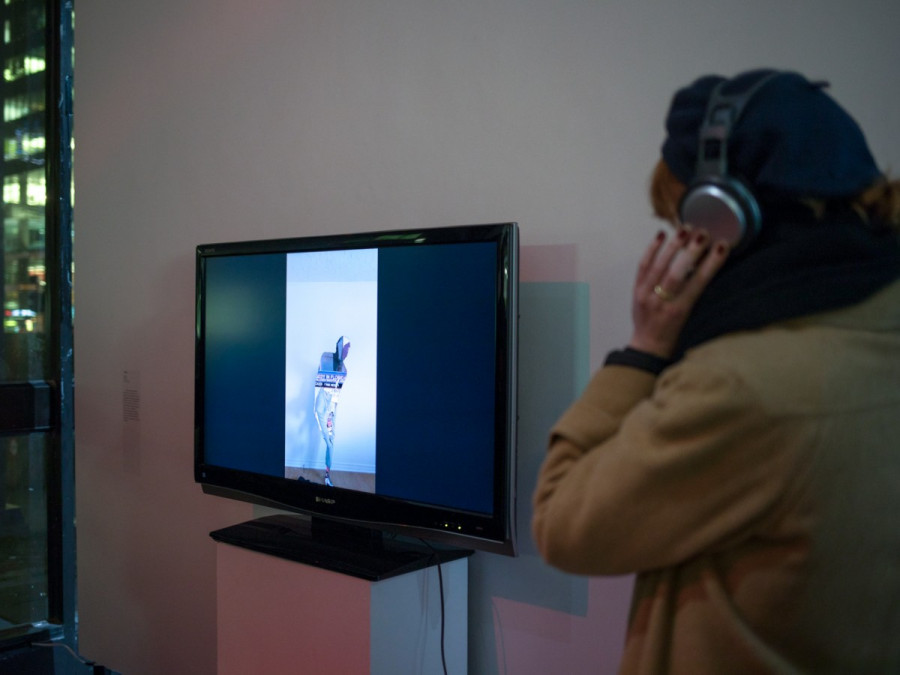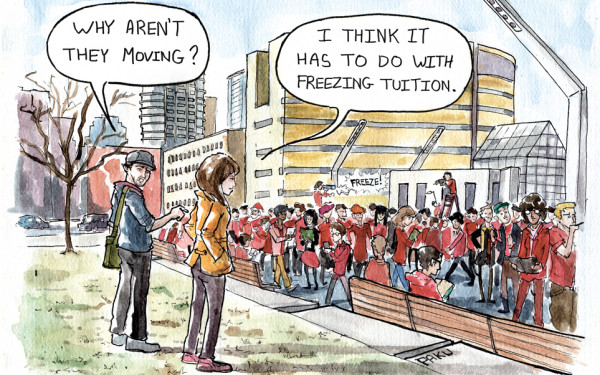Naf Leri, an Artist Who Owns His Politicized Identity
Overcoming Stereotypes and Shyness Through Art
Montreal-based artist Naf Leri is someone who believes his art to be a reflection of himself and the world around him in the simplest of ways.
“Arguably my pieces are not that deep,” Naf Leri jokes. “It’s just me drawing my sometimes uneasiness [and] awkwardness— things that are reflected in my personality. As for what I convey in my art […] low-key I still don’t know.”
“All I see, observe and learn, I like putting […] in my art,” Naf Leri continues.
Naf Leri is a fine arts student, majoring in design at Concordia University. The artist who uses the name Naf Leri as a pseudonym in his artistry, was featured last November at the Visual Arts Visuels Gallery’s Black History Month exhibition, Hyper Real.
“As an artist I can express myself every day and whenever,” Naf Leri says. “But as a Black artist you don’t have that much of a window to do so, so when I saw that exhibition I really wanted to do it.”
When asked if there is pressure to live up to a “Black artist” stature, he shrugs and admits he is more than happy to do it.
If someone is Black and they make art, they generally are only seen as a Black artist, and their art is viewed through a lens that solely represents Black experience, Naf Leri explains. Despite this generalization, Naf Leri decided to embrace it. “I choose to express myself as a Black artist […] I only get to do that in February, and when I got the chance in November, I used it.”
Related- Visual Artist David Durham Makes Art Out of Coffee
- “Naïka Deluy-Garwood Shaves Her Head and Turns the Moment Into Art”:“https://thelinknewspaper.ca/article/naika-deluy-garwood-shaves-her-head-and-turns-the-moment-into-art
- “ Hyperrealist Artist Daniel Itiose Exhibits Expressive Paintings at the VAV”:https://thelinknewspaper.ca/article/hyperrealist-artist-daniel-itiose-exhibits-expressive-paintings-at-the-vav
“There is somehow always an echo of my being a Black man in my work even if it isn’t the main focus,” he continues.
For Naf Leri’s work to translate well to his audience, he admits a certain understanding of the realities of Black lives is needed.
“It’s hard for someone who isn’t Black to understand [my art] how it should be,” he explains.
Naf Leri’s showcased pieces at the VAV last November were what he considered very intimate works. Although he is adamant on having fun while making art, he also illustrates how he is affected by the world around him.
One of the exhibition artworks entitled Trap reflected his personal take on the death of Eric Garner, an event that truly marked the artist.
In 2014, the NYPD approached Eric Garner, an African-American man, accusing him of selling illegal cigarettes. What followed was an altercation that resulted in Garner being pinned to the ground in a choke hold by a police officer. In a video shot by Garner’s friend who was at the scene of the event, Garner can be seen telling the officers he could not breathe multiple times. Garner then lost consciousness, and was pronounced dead in hospital one hour later.
Naf Leri’s piece _Trap_is a haunting digital artwork. In the piece, a Black man whose face is indiscernible is seen undressing before the viewer. An array of news headlines and videos are superimposed over his body, with a headline reading “Send the N**** Back Home,” shone in black and white among the cacophony. Piece by piece the man strips himself to his full nudity. By the end, all that is left of him is a figure covered head to toe in flashing scenes of police brutality and news stories, including footage of Garner’s death.
“To what extent do I owe society to show them that I am not what they perceive? I am aware [that] myself and other people in my community, as Black people, […] are not what society thinks we are. I’m just gonna try to live my life as best as I could.”
The piece is provocative, and straight to the point. The audience could possibly read this as a statement by the artist, alluding to the notion that no matter how much they try to prove otherwise, people of colour will always be defined by society’s take on them. They are “trapped” in the stereotypes and discrimination embedded in society because of their skin.
Another striking piece featured at the VAV in November is an illustration of a boy, surrounded by an array of people who are dancing and singing, and are not paying any attention to him.
Drawn from a lower angle, the audience is put at the same level as the boy of colour who is standing still in the sea of people, looking up at his entourage who seem full of joy.
This could be an interpretation of Naf Leri’s personality, as he describes himself as quite the shy character, and would consider himself more of an observer rather than someone who would willingly initiate conversations with strangers.
“It is so weird to be a shy person in art. Sometimes I draw people in the metro, and sometimes I forget people can see me, so when they come up to me and tell me what I’m doing is nice, my first instinct is to run away. But there’s an engagement in art, and I’m still trying to reconcile this aspect of my life with my shyness.”
The most important thing to Naf Leri when it comes to his work is to remain natural. As far as he can tell, creating his pieces never felt forced, and he tries to keep it this way, as he wants to keep his art fun, no matter the subject.
“How would I describe my art?” he wonders. “I’m just playing, honestly. Right now, I’m playing with stickers. I’m just trying to play and have fun and be amused. I’m enjoying having discussions with people [about my work].” Having fun with his art feels natural to him, he continues.
When asked if his need for maintaining this playful element in his art is a way to go against the stereotypical ‘angry Black people’ label, he shakes his head.
“To what extent do I owe society to show them that I am not what they perceive? I am aware [that] myself and other people in my community, as Black people, […] are not what society thinks we are,” he says. “I’m just gonna try to live my life as best as I could.”
“It should be our duty to represent ourselves rather than wait for [society] to represent us. By just being, and not being a stereotype, […] I’m showing you that we are not all the same.”
For more of Naf Leri’s works, you can check out his Instagram account, @nafleri.


_600_832_s.png)

2_600_375_90_s_c1.jpg)
1_600_375_90_s_c1.jpg)

